Tuesday, January 27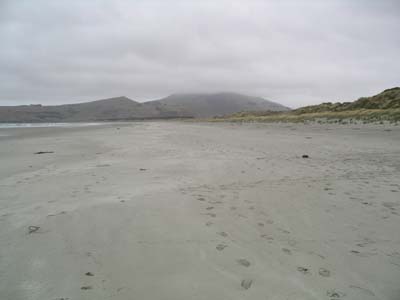
Steve: This morning was still cloudy and rainy, so we took advantage of the time to catch up on writing, reading and schoolwork. By afternoon, the skies had begun to brighten, and we headed to the Okia Reserve and a walk to Victory Beach. This walk had been highly recommended to us - we had been told that it was possible here to see penguins, seals and sea lions.
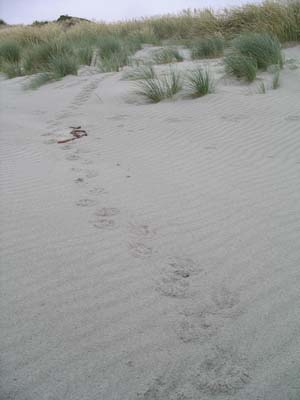 Victory
Beach is extremely wide, and is lined with dunes that look just like the penguin
nests that we saw during our trip to the Penguin Reserve. We quickly saw some
of the telltale penguin tracks leading from the beach up to the dunes, and
shortly afterwards we saw our first penguin slowly walking from the water.
He clearly saw us and sped up his walk toward his nest, but it was great to
see him walking alone on this huge beach. Even though we weren't nearly as
close as we were at the Penguin
Victory
Beach is extremely wide, and is lined with dunes that look just like the penguin
nests that we saw during our trip to the Penguin Reserve. We quickly saw some
of the telltale penguin tracks leading from the beach up to the dunes, and
shortly afterwards we saw our first penguin slowly walking from the water.
He clearly saw us and sped up his walk toward his nest, but it was great to
see him walking alone on this huge beach. Even though we weren't nearly as
close as we were at the Penguin 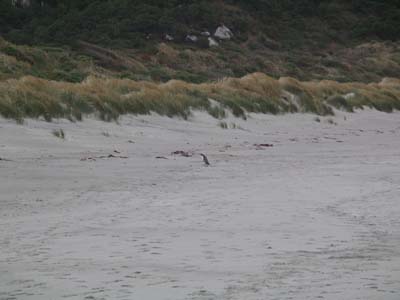 Reserve,
there's something special about encountering a rare bird like this on our
own. We did manage to get a reasonable photo of him (he's in the middle of
the picture on the right), just to prove that we saw our own penguin!
Reserve,
there's something special about encountering a rare bird like this on our
own. We did manage to get a reasonable photo of him (he's in the middle of
the picture on the right), just to prove that we saw our own penguin!
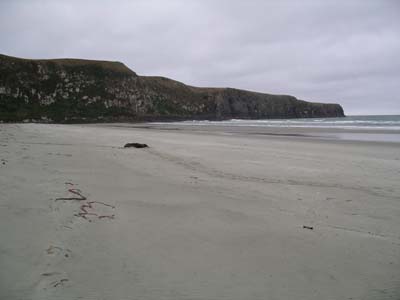 We
also saw another huge Hookers Sea Lion on the beach. This guy was sound asleep
(he's the black blob in the picture on the left), and given our new understanding
of how they can attack people, we kept much more distance than the last time.
Before we left, we saw another three penguins - not bad for a quick trip to
the beach…
We
also saw another huge Hookers Sea Lion on the beach. This guy was sound asleep
(he's the black blob in the picture on the left), and given our new understanding
of how they can attack people, we kept much more distance than the last time.
Before we left, we saw another three penguins - not bad for a quick trip to
the beach…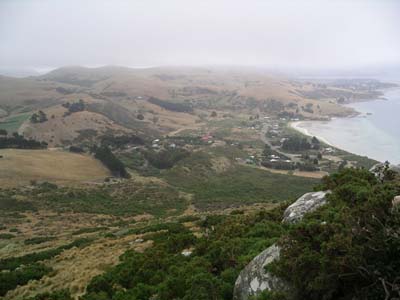
We also took an 8-wheel buggy tour on a large farm that sits near the end
of the peninsula. We couldn't believe that all this land was privately owned
- it contains miles of rocky shoreline, beaches, and grazing pastures, much
of it with fantastic views of the entire peninsula. Th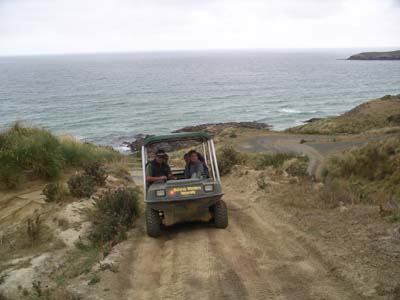 e
buggies are built to quickly travel up and down rocky hills, and provided
a surprisingly fun and comfortable ride. Our tour took us to the top of a
large hill with great views, down to a colony of fur seals along a rocky shore,
and to "Penguins Beach" where we saw more Yellow Eyed Penguins nesting
and walking on the beach. We especially enjoyed watching fur seals playing
in the water, and a young pup being nursed by its mother. We were able to
watch the pup from a close distance due to a special hide that has been built
along the shore.
e
buggies are built to quickly travel up and down rocky hills, and provided
a surprisingly fun and comfortable ride. Our tour took us to the top of a
large hill with great views, down to a colony of fur seals along a rocky shore,
and to "Penguins Beach" where we saw more Yellow Eyed Penguins nesting
and walking on the beach. We especially enjoyed watching fur seals playing
in the water, and a young pup being nursed by its mother. We were able to
watch the pup from a close distance due to a special hide that has been built
along the shore.
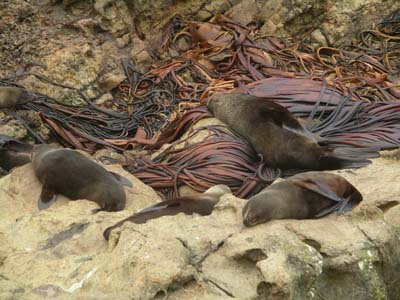
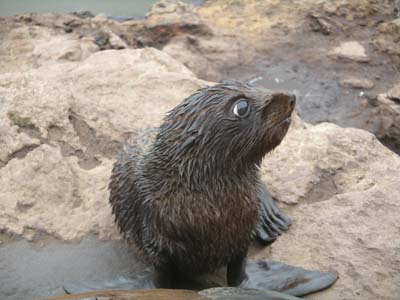
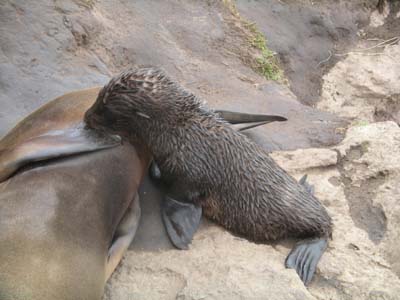
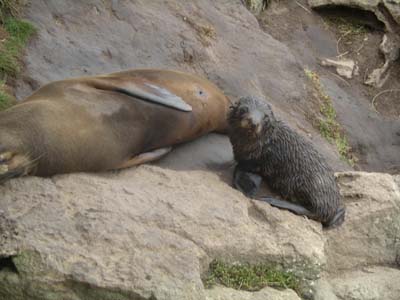
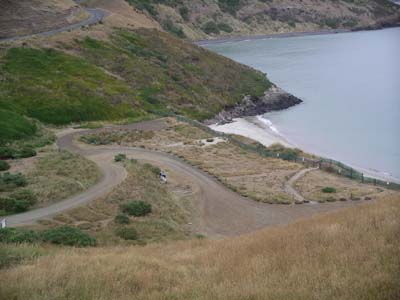
This evening we returned to Pilot Beach to see the Blue Penguins arrive from sea and march together up the beach to their nests. Tonight we counted 28 penguins, and a naturalist was on hand to point them out as they swam to shore. They appeared as a dark cloud in the water, and then suddenly popped out on the beach, all at once. This picture shows Pilots Beach during the daytime. The penguins walk up the path that's shown coming from the beach, and to their nests that are spread all through the area shown.
Today was our last day on the South Island, and tomorrow morning we'll fly to Auckland.
Katie's Komments - Royal Albatross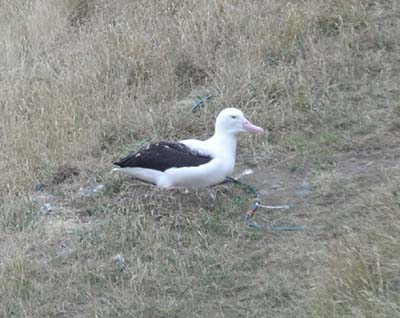
This week we went to a really cool Royal Albatross Reserve in Taiaroa. We learned a lot about these fascinating birds and even got to see them nesting and flying with our own eyes. The first time I saw one of these birds flying I was completely amazed. They looked more like those huge flying pterodactyl dinosaurs, than any bird I'd ever seen. Let's put it this way, they were huge! These monstrous birds have an average wing span of about 9 feet. The structure of their wings is also very unique. They are made up of three segments; however the albatross don't usually flap them. Instead they glide in the wind, adjusting their wings as they go. They fly a maximum speed of 100 kilometers per hour - that's about 65 miles per hour. While in the observatory we were lucky enough to see one fly right over the roof, which really gave us a sense for their size and beauty.
Royal Albatrosses spend about 80% of their life at sea, which means they need some special qualities to survive when drinking the salty water. We learned that the glands in the top of their forehead extract the extra salt from the albatross's body and drain it through a part of their beak. Their diet consists of squid, crayfish, and other sea creatures, usually the dying ones which float to the top of the water. Most nest on the Chatham Islands of New Zealand because they have lots of wind and no people living on them. The Taiaroa Reserve is the only one in the world which provides opportunities to see these albatross.
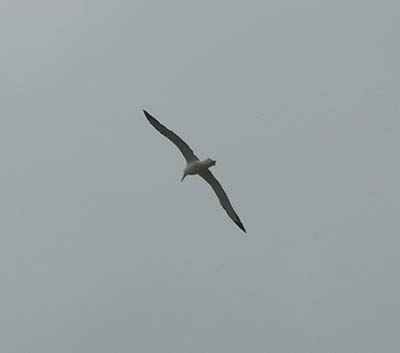 Royal
Albatrosses are thought to fly great distances, circling around Antarctica
and the Southern Hemisphere, however no one knows for sure. There have been
some efforts to try and track these birds, but unfortunately none have come
into play yet. They do put bands on the birds' wings at certain ages to keep
track of each albatross' individual history, health status etc. Royal Albatross',
as I said spend, most of their life at sea, however they do come back to land
every other year to breed. They mate for life and have one chick each year
that they breed. When the chick hatches it is tiny, and the parents take turns
sitting on the nest and finding food. The chicks are often eaten by small
animals such as stoats and ferrets. There have been many efforts to kill as
many of these animals as possible, using traps, etc. At 3 months, however,
these birds are no longer vulnerable. The chicks get very hungry and can eat
4 lbs. of food in 14 minutes. Wow!!! At this time they are twice the size
and weight of their own parents - 14-20 lbs. The parents then start putting
the chick on a diet and the chicks thankfully begin to loose a little weight.
They then start learning how to fly on their own. When they have finally perfected
catching the wind, they go out on their own and don't return for 3-4 years,
before they decide it is time for them to find a mate. They are very independent
and solitary birds. The albatross will return to its colony and try to find
a mate which it keeps for life. The cycle begins once again.
Royal
Albatrosses are thought to fly great distances, circling around Antarctica
and the Southern Hemisphere, however no one knows for sure. There have been
some efforts to try and track these birds, but unfortunately none have come
into play yet. They do put bands on the birds' wings at certain ages to keep
track of each albatross' individual history, health status etc. Royal Albatross',
as I said spend, most of their life at sea, however they do come back to land
every other year to breed. They mate for life and have one chick each year
that they breed. When the chick hatches it is tiny, and the parents take turns
sitting on the nest and finding food. The chicks are often eaten by small
animals such as stoats and ferrets. There have been many efforts to kill as
many of these animals as possible, using traps, etc. At 3 months, however,
these birds are no longer vulnerable. The chicks get very hungry and can eat
4 lbs. of food in 14 minutes. Wow!!! At this time they are twice the size
and weight of their own parents - 14-20 lbs. The parents then start putting
the chick on a diet and the chicks thankfully begin to loose a little weight.
They then start learning how to fly on their own. When they have finally perfected
catching the wind, they go out on their own and don't return for 3-4 years,
before they decide it is time for them to find a mate. They are very independent
and solitary birds. The albatross will return to its colony and try to find
a mate which it keeps for life. The cycle begins once again.
As you can see, we learned a lot about Royal Albatross, and were completely fascinated by the brilliance of this bird and the people of New Zealand, who work so hard to protect these amazing birds and other native animals for the next generation to see.
David's Download - Yellow Eyed Penguins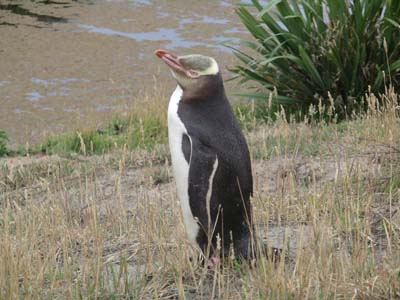
This week we visited the Yellow Eyed Penguin Conservation Reserve, where we saw one of the rarest and most spectacular penguins on earth: the Hoiho. The Hoiho Penguin, or Yellow Eyed Penguin, is native to New Zealand and can only be seen in this country.
The Penguin Place (conservation reserve) had an extremely unique set-up. Down on the beach in the middle of the penguin's territory, they had a series of waist deep trenches and hides, through which you could easily observe the penguins in close quarters. The beach could easily be mistaken for a World War 1 battle field, with intricate trenches camouflaged with bushes and dried leaves. Walking through these channels was really cool. I felt like a soldier jogging through dugouts trying to follow the Germans, and guessing what their next move would be! You would think at first that the penguins would still be frightened if they saw ten or more faces peering out at them wherever they went. This method of hides is effective because the penguins can only see your faces! They immediately assume you are smaller than they are, and are not disturbed. I loved being able to see these rare penguins up close in their natural habitat, without alarming them.
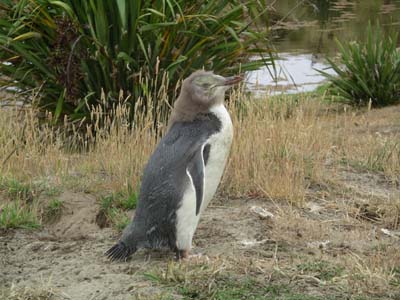 The
Yellow Eyed Penguin is an extremely rare and protected bird. They are very
independent and are particularly territorial. They are also one of the largest
penguins on earth, and can grow up to 2 feet tall! Their yellow eyes, snow
white chests, and black backs are magnificent. I especially like the hair
on their head which looks as if it is dyed gold with slick black streaks.
Seeing the penguins hop out of the water, shake off, and wobble back to their
chicks created an unforgettable memory for me. They were one of the coolest
animals I have ever seen! The penguins can live for up to 20-25 years, and
can raise over 20 chicks in their life. They breed for 12 weeks and can have
up to two chicks any given breeding season. The parents take turns incubating
the eggs and regurgitating their food to feed the chicks. The penguins also
molt every year for four months. During this stage, they lose all their feathers
and grow new ones. They cannot fish during this time because their feathers
are not yet waterproof. They must get extremely fat before molting so they
do not die of starvation while molting.
The
Yellow Eyed Penguin is an extremely rare and protected bird. They are very
independent and are particularly territorial. They are also one of the largest
penguins on earth, and can grow up to 2 feet tall! Their yellow eyes, snow
white chests, and black backs are magnificent. I especially like the hair
on their head which looks as if it is dyed gold with slick black streaks.
Seeing the penguins hop out of the water, shake off, and wobble back to their
chicks created an unforgettable memory for me. They were one of the coolest
animals I have ever seen! The penguins can live for up to 20-25 years, and
can raise over 20 chicks in their life. They breed for 12 weeks and can have
up to two chicks any given breeding season. The parents take turns incubating
the eggs and regurgitating their food to feed the chicks. The penguins also
molt every year for four months. During this stage, they lose all their feathers
and grow new ones. They cannot fish during this time because their feathers
are not yet waterproof. They must get extremely fat before molting so they
do not die of starvation while molting. 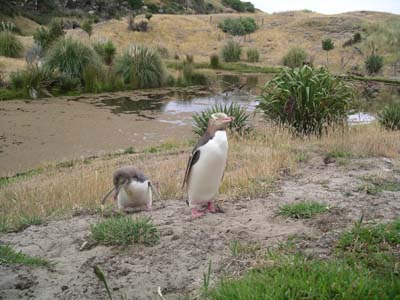
There are extreme measures being taken at the moment to protect and preserve these birds. There are only 4,000 left, but have been slowly building up their numbers. Almost every breeding site has been created into a reserve, with access permitted only with a guide. Hopefully these birds will soon become common again, and will no longer have to worry about extinction.
One of the things I found to be both amazing and comical was how the guides treated the colony like a human suburb! Each penguin had a name and property! For example, one of the penguins we saw was named Paul. The guides constructed a life summary of Paul, and told us what he had been doing lately. Paul is a huge property owner and owns a whole pond and hill. If any penguin swims in his pond, he gets a beating. We heard that Paul had been a bachelor for a number of years, flirting with many women, until a female named Jill came along. Jill had been mating with Jack for eight years, until Jack passed away at sea. Jill and Paul have now been mating for a couple years. We also heard that recently a male named Tarzan had advanced on Jill when Paul was out fishing. Jill beat him up, refusing to cheat on Paul. The next day Tarzan came again, only to find Paul and Jill were there. Tarzan supposedly got pinned to the ground by both of them, and got bit, slapped, and pecked. Tarzan never got near Jill again. The guide also told us stories of other big fights, social events, and love affairs. We all thought this was pretty cool!
